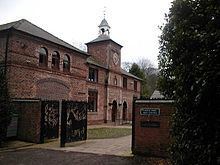OS grid reference SJ 514,775 Rebuilt 1850s | Built Late 18th century | |
 | ||
Area Over 24 acres (97,000 m) Built for Robert Wainwright Ashley Similar Hough Green Park, Horticultural Centre, Blackleach Country Park, Manor Park, Court Hey Park | ||
Castle Park House is a former country house surrounded by extensive grounds in the market town of Frodsham in Cheshire, England. It is built on the site of Frodsham Castle, and originates from the late 18th century. It was extended in the 1850s, and its gardens were laid out by Edward Kemp. The house passed into the ownership of the local council, and is used for a variety of functions. Its grounds are a public park.
Contents
Map of Castle Park House, Frodsham WA6 6SB, UK
History
The house is built on the site of Frodsham Castle which burnt down in 1654. In the late 18th century the first house on the site, Park Place, was built by Robert Wainwright Ashley, a lawyer in the town. On his death the house was inherited by his eldest son, Major Daniel Ashley II until his death in 1841. It was then inherited by his brother Reverend Thomas Ashley, but mortgaged to Philip Humberston of Chester. During this time it was leased to Captain Harry Heron.
In 1851 it was bought by Joseph Stubs of Warrington, a manufacturer of engineers' tools. He started to develop and extend the house and outbuildings and commissioned Edward Kemp to lay out the woods and gardens, which comprised an area of more than 24 acres (97,000 m2). The architect for the rebuilding was probably T. M. Penson. Its style is "reserved Italianate". Stubs did not live to see the work completed as he died in 1861. It was bought by auction for over £9,500 (equivalent to £800,000 in 2015) by Edward Abbott Wright, a Quaker cotton manufacturer from Oldham. The house then came to be known as Castle Park. The Wrights had five children, a boy who died at the age of 14, and four girls. Edward's wife died in 1868 and Edward continued to live in the house, commuting for his business and political interests from Frodsham railway station, until he died at the age of 83 in 1891. Following this, Edward's two unmarried daughters, Harriet and Emily continued to live in the house until the last remaining daughter, Harriet died in 1931.
Today
The grandchildren of Edward, who were the beneficiaries of the will, presented the house and 12 acres (49,000 m2) of ornamental grounds to the Runcorn Rural District Council (of which Frodsham was at that time a part) for the "use, enjoyment and benefit" of the inhabitants. The grounds were used as a public park and the house as the offices of the Rural District Council. After the reorganisation of 1974 the ground floor was used by Vale Royal Borough Council and Frodsham Parish Council.
In 2006 the house had a major refurbishment and is now used for a variety of purposes. The house is owned by Cheshire West and Chester Council who provide one stop shop facilities for local council services, and adult learning centre, and for conferences. The archives of the Frodsham and District Local History Group are held in the house.
History
Edward Kemp's plan was for a formal garden containing a conservatory and plant houses to the north of the house. Beyond these were a garden yard, a stable yard, a coach house and a farm yard. To the west of these was a substantial kitchen garden. The other outbuildings included a vinery, with a heated wall, and a smoke house for curing bacon and ham. Joseph Stubs was a collector of rare plants and many of these were planted in what he called the American Garden. In the days of the Wright family a head gardener and seven full-time gardeners were employed and also during this time more outbuildings were constructed beyond the coach house.
Today
An extensive area of parkland stretches up the hill to the west of the house. Some of the trees planted by Joseph Stubs are still present, although coming to the end of their lives. The formal garden is still there and a garden for the disabled has been constructed by Frodsham Round Table. In the park there are play facilities for children. The coach house has been developed into the Castle Park Arts Centre which has a small café and showrooms for the arts. Other outbuildings are now used as offices for small businesses. The park and gardens have been designated at Grade II in the National Register of Historic Parks and Gardens.
